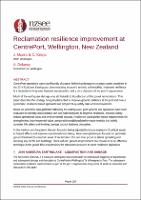Reclamation resilience improvement at CentrePort, Wellington New Zealand

Download
Date
2022-04-27Authors
Keepa, Campbell
Munro, James
Delaney, Anthony
Metadata
Show full item recordAbstract
CentrePort operations were significantly disrupted following damage to strategic assets sustained in the 2016 Kaikōura Earthquake, demonstrating the ports seismic vulnerability. Improved resilience is a necessity to long-term business sustainability and a core objective of the port’s regeneration.
Much of the earthquake damage was attributable to liquefaction of the gravel reclamations. This paper describes the strategy being implemented to improve ground resilience at the port and how a systematic, resilience based approach was adopted to quantify risks and improvements.
Based on extensive data gathered following the earthquakes, port systems and operations have been evaluated to identify and prioritise soft and hard measures to improve resilience, enhance safety, reduce operational costs and environmental impacts. Resilience based performance requirements for strengthening have improved value compared to traditional performance metrics that solely consider life safety and limiting damage but not business disruption.
In the medium and long term, the port layout is being adjusted to reduce exposure of critical assets to hazard effects and improve operational redundancy. Asset strengthening is focused on perimeter ground treatment to constrain areas of reclamation that are most prone to lateral spreading and securing key berths and buildings. Stone column ground improvement has proven to be an effective technique in the gravel fills and provides the robustness required to meet resilience objectives.
